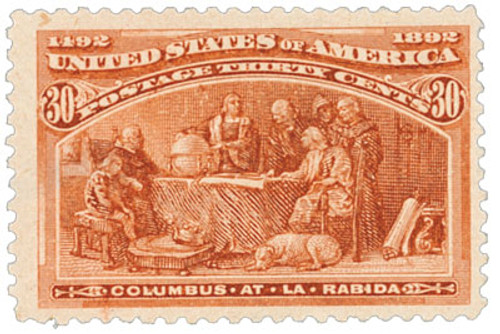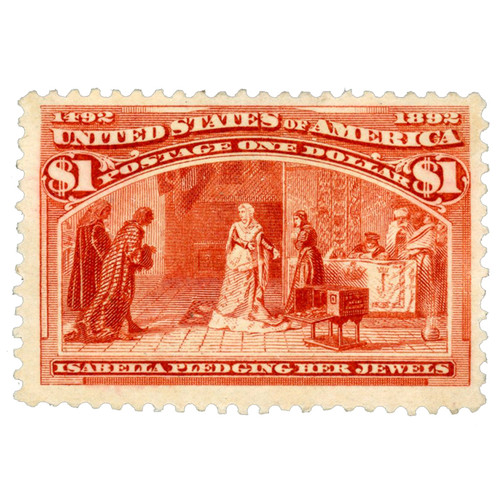
1893 $5 Columbus, black
# 245 - 1893 $5 Columbus, black
$780.00 - $9,750.00
U.S. #245
1893 $5 Columbian
1893 $5 Columbian
First Day of Issue: January 2, 1893
Quantity issued: 27,350 (5,506 destroyed)
Printed by: American Bank Note Company
Method: Flat Plate in sheets of 100 subjects
Watermark: None
Perforation: 12
Color: Black (with gray black shade known)
Explorer Christopher Columbus is the subject of U.S. #245. The stamp’s central design was taken from a medal struck in Madrid. The Treasury Department made a cast, from which both the stamp and the 50¢ Columbian Commemorative Half Dollar were made. As a result, this image of Columbus is the one most associated with the 1893 World’s Fair. Unlike the medal, the $5 stamp features the figures of Liberty on Columbus’ left and America on his right.
Low Issue Quantity
In 1893, the $5 face value was equal to several hundred dollars in today’s wages. The issue quantity was low to meet the predicted demand – only 27,350 $5 Columbian stamps were issued. Only 21,844 of them were sold. The unsold stamps were destroyed.
The New York Times alleged the $5 denomination didn’t have a genuine philatelic use since the heaviest printed material the Post Office would handle was four pounds – which cost 64¢. However, used U.S. #245 stamps are known.
Printed by the American Bank Note Company
The 1893 Columbian Series was printed by the American Bank Note Company. The engraving was done by Alfred Jones and Charles Skinner. The stamps were printed in black ink in sheets of 100 subjects on soft porous white wove paper and perforated 12. A fairly common grayish black shade is known.
About the Columbian Series
The Columbian Series is a milestone in American history. Its impact on stamp collecting was so great that the series’ degree of completion is often the “yardstick by which a U.S. collection is measured” (Max Johl, 1947).
The series was issued in advance of Chicago’s 1893 World Columbian Exposition, an international fair celebrating the 400th anniversary of Christopher Columbus’ 1492 arrival in the New World. The series was used to advertise the event – the first time postage stamps were used to promote a commercial event.
The 1893 Columbian Exposition stamp series was like nothing before it. The Columbians were the first U.S. commemorative stamps, and they created a worldwide phenomenon. Expertly engraved and generous in size, the Columbians are among the most sought-after of all U.S. stamps.
An Instant Hit with Collectors
At the time they were issued, the Columbian stamps were controversial. Collectors eagerly awaited the series, forming long lines to purchase the stamps. Yet many were frustrated by the price of owning the complete series, which equaled more than $2,030 in today’s unskilled labor wages. Some postal clerks refused to sell Columbian stamps because demand far exceeded supply.
As a consequence, used Columbian stamps were selling for almost full face value in 1893 – even as mint stamps were officially on sale. The craze for Columbian stamps was even more pronounced in Europe, where collectors hounded American tourists and begged for stamps from their mail. A corner of Hamburg’s stock exchange was devoted to trafficking Columbian stamps. On August 11, 1893, the New York Times reported these transactions were conducted “as carefully as they handled the highest gilt-edged securities.”
U.S. #245
1893 $5 Columbian
1893 $5 Columbian
First Day of Issue: January 2, 1893
Quantity issued: 27,350 (5,506 destroyed)
Printed by: American Bank Note Company
Method: Flat Plate in sheets of 100 subjects
Watermark: None
Perforation: 12
Color: Black (with gray black shade known)
Explorer Christopher Columbus is the subject of U.S. #245. The stamp’s central design was taken from a medal struck in Madrid. The Treasury Department made a cast, from which both the stamp and the 50¢ Columbian Commemorative Half Dollar were made. As a result, this image of Columbus is the one most associated with the 1893 World’s Fair. Unlike the medal, the $5 stamp features the figures of Liberty on Columbus’ left and America on his right.
Low Issue Quantity
In 1893, the $5 face value was equal to several hundred dollars in today’s wages. The issue quantity was low to meet the predicted demand – only 27,350 $5 Columbian stamps were issued. Only 21,844 of them were sold. The unsold stamps were destroyed.
The New York Times alleged the $5 denomination didn’t have a genuine philatelic use since the heaviest printed material the Post Office would handle was four pounds – which cost 64¢. However, used U.S. #245 stamps are known.
Printed by the American Bank Note Company
The 1893 Columbian Series was printed by the American Bank Note Company. The engraving was done by Alfred Jones and Charles Skinner. The stamps were printed in black ink in sheets of 100 subjects on soft porous white wove paper and perforated 12. A fairly common grayish black shade is known.
About the Columbian Series
The Columbian Series is a milestone in American history. Its impact on stamp collecting was so great that the series’ degree of completion is often the “yardstick by which a U.S. collection is measured” (Max Johl, 1947).
The series was issued in advance of Chicago’s 1893 World Columbian Exposition, an international fair celebrating the 400th anniversary of Christopher Columbus’ 1492 arrival in the New World. The series was used to advertise the event – the first time postage stamps were used to promote a commercial event.
The 1893 Columbian Exposition stamp series was like nothing before it. The Columbians were the first U.S. commemorative stamps, and they created a worldwide phenomenon. Expertly engraved and generous in size, the Columbians are among the most sought-after of all U.S. stamps.
An Instant Hit with Collectors
At the time they were issued, the Columbian stamps were controversial. Collectors eagerly awaited the series, forming long lines to purchase the stamps. Yet many were frustrated by the price of owning the complete series, which equaled more than $2,030 in today’s unskilled labor wages. Some postal clerks refused to sell Columbian stamps because demand far exceeded supply.
As a consequence, used Columbian stamps were selling for almost full face value in 1893 – even as mint stamps were officially on sale. The craze for Columbian stamps was even more pronounced in Europe, where collectors hounded American tourists and begged for stamps from their mail. A corner of Hamburg’s stock exchange was devoted to trafficking Columbian stamps. On August 11, 1893, the New York Times reported these transactions were conducted “as carefully as they handled the highest gilt-edged securities.”



















